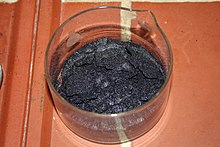Haemines
Hemins (Chloroeisen (III) porphyrin coordination complexes) are complex compounds of the heme with the iron ion in the oxidation state (+ III) and a chloride ion as axial ligands .
properties
The hemin b of the heme b is briefly as hemin designated with the empirical formula C 34 H 32 N 4 O 4 · FeCl, molecular weight 651.94 g / mol, and the CAS number 16009-13-5. It forms elongated, thin platelets or characteristic beveled prisms, which appear brown when viewed through and shiny steel blue when reflected light.
Hemin a forms green crystals.
Hemines are insoluble in water and dilute acids, but soluble in strong bases. Haemines form haematins in inorganic bases and haemochromes or haemochromes in organic bases.
history
The Krakow anatomist Ludwig Karol Teichmann (Ludwik Karol Teichmann-Stawiarski; 1823–1895) crystallized hemin from blood for the first time in 1853. The German chemist Hans Fischer received the Nobel Prize for Chemistry in 1930 for the synthesis of heme .
proof
Haemin in the form of typical crystals is created in the so-called Teichmann test from hemoglobin when heated with acetic acid (glacial acetic acid, saturated with table salt) to detect traces of blood .
use
Human hemin obtained from human blood is used in the form of a concentrate for infusion ( Normosang ® , Orphan Europe, France) for the treatment of acute relapses in patients with acute hepatic porphyria and is subject to medical prescription. Porphyrias are usually congenital disorders in the formation of the heme group, characterized by the partial failure of enzymes that catalyze the 8 successive steps in the formation of heme . The heme group occurs mainly in hemoglobin (red blood pigment), but also in enzymes such as cytochrome P450 , which among other things plays a role in the breakdown / detoxification of xenobiotics (e.g. drugs) in the liver. If more drugs have to be broken down, there is an increased need for cytochrome P450 and a positive feedback on the heme synthesis pathway. If the synthesis path is disturbed, however, the positive feedback leads to an enrichment of the metabolic product, which cannot be converted (further processed) at the normal rate and a porphyria surge occurs (porphyrin precursors are toxic for the body).
Hemin arginate occupies the positive feedback point in the synthesis path (it suggests to the body that a sufficient amount of heme is present) and causes the feedback to be decoupled.
literature
- ↑ J. Stahnke: Ludwik Teichmann (1823–1895). Anatomist in Krakow. In: Würzburger medical historical reports 2, 1984, pp. 205–267.
- ↑ L. Teichmann: About the crystallization of the organic components of the blood . In: Journal for rational medicine (new episode) . tape 3 , no. 3 , 1853, p. 375–388 ( full view in Google Book search).
- ↑ Ludwik Teichmann: About the hematin. In: Journal for rational medicine , new series 8, 1859, pp. 141–148.
- ^ Information from the Nobel Foundation on the award ceremony in 1930 to Hans Fischer (English) .
- ↑ Jürgen Thorwald : The hour of the detectives. Becomes and worlds of criminology. Droemer Knaur, Zurich and Munich 1966, pp. 31–35.
- ↑ J. Stahnke: Häminkristalle. Ludwik Teichmann's blood certificate. In: Medical History Journal. Volume 16, 1981, pp. 391-413.

